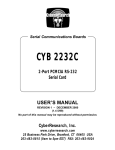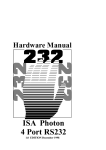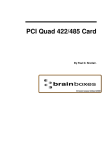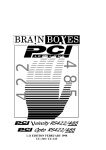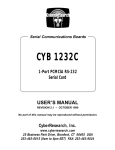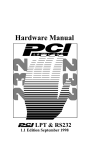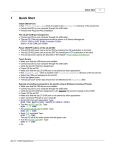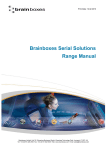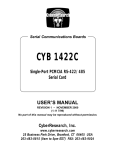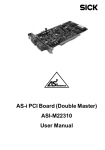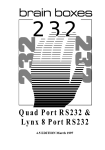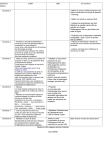Download CyBD 8232P MANUAL
Transcript
Serial Communications Boards
CYBD 8232P
8-Port PCI RS-232
Serial Communication Card
USER’S MANUAL
REVISION 2.1 – JANUARY 1999
No part of this manual may be reproduced without permission.
CyberResearch, Inc.
www.cyberresearch.com
25 Business Park Drive, Branford, CT 06405 USA
203-483-8815 (9am to 5pm EST) FAX: 203-483-9024
©1994 CBI ©1997 CyberResearch, Inc.
©Copyright 1998 CyberResearch, Inc.
All Rights Reserved.
The information in this document is subject to change without prior notice in order to
improve reliability, design, and function and does not represent a commitment on the
part of CyberResearch, Inc.
In no event will CyberResearch, Inc. be liable for direct, indirect, special, incidental, or
consequential damages arising out of the use or inability to use the product or
documentation, even if advised of the possibility of such damages.
This document contains proprietary information protected by copyright. All rights are
reserved. No part of this manual may be reproduced by any mechanical, electronic,
or other means in any form without prior written permission of CyberResearch, Inc.
TRADEMARKS
“CyberResearch” and “CYBD 8232P” are trademarks of CyberResearch, Inc. Other
product names mentioned herein are used for identification purposes only and may be
trademarks and/or registered trademarks of their respective companies.
• NOTICE •
CyberResearch, Inc. does not authorize any CyberResearch product for use in life
support systems, medical equipment and/or devices without the written approval of the
President of CyberResearch, Inc. Life support devices and systems are devices or
systems which are intended for surgical implantation into the body, OR support or
sustain life and whose failure to perform can be reasonably expected to result in injury.
Other medical equipment includes devices used for monitoring, data acquisition,
modification, or notification purposes in relation to to life support, life sustaining, or
vital statistic recording. CyberResearch products are not designed with the
components required, are not subject to the testing required, and are not submitted to
the certification required to ensure a level of reliability appropriate for the treatment
and diagnosis of humans.
These product conform to the following standards:
CE Standard:
IEC 801-2:
IEC 801-3:
IEC 801-4:
TIA/EIA:
EN55022:1987 Class B
1991 Level 2
1984 Level 2
1988 Level 2
232 - E
©2000 CyberResearch, Incorporated • Branford, Connecticut, USA
•
Tel: (203) 483-8815 • Fax: (203) 483-9024
CyBD 8232P MANUAL
THE LAYOUT OF THIS MANUAL
Chapter 1 - CyBD 8232P Hardware Configuration, Summarises the features of the PCI CyBD
8232P Card.
Chapter 2 – Installing the card into the PC,
Explains how to open the PC and insert a new serial card
Chapter 3 – CyBD 8232P Software Installation
This chapter details how to install and configure the
CyBD 8232P Card in Windows 3.x, Windows 95/98
and Windows NT.
Chapter 4 – RS232 Port Cabling
INTRO 3
Index
CyBD 8232P MANUAL ...............................................3
CHAPTER 1 HARDWARE SPECIFICATIONS......6
Introduction. .......................................................................... 6
WARNING For Windows 98 Users Only. ............................. 6
CyBD 8232P Card Features.................................................. 6
CyBD 8232P Card Specifications. ........................................ 7
Configuring CyBD 8232P Cards............................................ 7
CHAPTER 2 INSTALLING THE CARD .................8
Serial Carrd Installation. ......................................................... 8
Problems! ............................................................................ 10
CHAPTER 3 SOFTWARE INSTALLATION .........11
Introduction. ........................................................................ 11
Configuring Ports In Windows 3.x....................................... 11
Determining CyBD 8232P Resources. .................................. 11
Serial Solutions Installation for Windows 3.x ...................... 13
Serial Port Installation. ........................................................ 14
Adding an PCI CyBD 8232P Serial Card............................. 15
Settings for CyBD 8232P Card COM1 Present .................... 17
Settings for CyBD 8232P Card COM1 & 2 Present ............. 19
Settings for CyBD 8232P Card COM1 to 4 Present ............. 21
Configuring The COM Ports................................................ 23
Changing Serial Port Settings .............................................. 23
Deleting Ports in Windows. ................................................. 24
Restarting Windows............................................................. 24
Configuring Ports in Windows 95 and 98. ........................... 25
Windows 95/98 Installation Procedures ............................... 25
CyBD 8232P Card Settings In Win95/98............................. 27
CyBD 8232P Card Port Settings In Win 95/98. ................... 29
Maximum Baud Rate Settings.............................................. 30
Configuring CyBD 8232P Ports In Windows NT. ............... 33
Software Installation............................................................ 33
Examining Card Configuration. ........................................... 34
Changing Serial Port Settings .............................................. 35
INTRO 4
Advanced Port Settings........................................................ 36
Uninstalling Serial Solutions for Windows NT .................... 38
CHAPTER 4
RS232 PINOUTS AND PORT
CABLING. ..................................................................39
Introduction. ........................................................................ 39
The RS232 Standard. ........................................................... 39
Serial Port Pin Outs. ............................................................ 40
9 Pin D Serial Port Connection To Another PC. .................. 41
9 Pin D Serial Port To A Modem......................................... 43
9 Pin D Serial Port Loop Back Connector............................ 43
The CyBD 8232P Card Octopus Cable Pinouts ................... 46
INTRO 5
CHAPTER 1
HARDWARE SPECIFICATIONS
Introduction.
This chapter details the specifications of the CyBD 8232P
serial card. These half-sized cards will work happily in any PCI
2.0 (or greater) compliant PC compatible.
WARNING For Windows 98 Users Only.
Each CyBD 8232P Card should be fully installed before adding
additional PCI CyBD 8232P cards.
CyBD 8232P Card Features.
* Eight independent RS232 Serial ports.
* Reliable communications up to 50 feet, 15m, and beyond!
* 100% 16C550 PC Compatible serial port, up to 230,400 baud.
16550 Compatible FIFO provides 128 byte input and 128 byte
output buffer on each port.
* Full modem control TXD, RXD, DSR, DCD, DTR, RTS, CTS
and RI signals.
* Fully double buffered for reliable asynchronous operation.
High speed integrated circuitry ensures operation with fast PC’s
e.g. 500 MHz Pentium II .
* Fully PCI 2.1 compliant.
* Fully Plug and Play
* Interrupt sharing system allows all ports to use a single interrupt
line while preventing any one port from hogging the processor.
Chapter 2 Page 6
CyBD 8232P Card Specifications.
Dimensions:
I/O Connection:
4.8 x 3.8 in, 120 x 95 mm
78 way female D connector
Fully moulded 8 Port cable with EITHER 9
or 25 pin D connectors.
Also, refer to Chapter 4 "RS232 Pinouts and Port Cabling" for
more detailed information on RS232 cabling, ports and pinouts.
Configuring CyBD 8232P Cards.
The CyBD 8232P cards are fully “ plug and play”,
and require no hardware configuration. They can be
installed "directly from the box".
Chapter 2 Page 7
CHAPTER 2
INSTALLING THE CARD
Serial Carrd Installation.
Once the card has been correctly configured then it can be
installed in the PC.
After installing the card and configuring the software the
cables should be attached and communication with the serial
peripheral devices should be established.
Provided that the RS232 installation is attacked in this
orderly manner, everything should work first time. If it does not
then check the software selectable communications parameters,
Baud rate, Parity, stop bits first, and that the communications
program is attempting to access the serial port installed. If this
fails to solve the problem check the cable connections. Finally
check that the card is indeed configured as you believed!
NOTE: Always turn the computer OFF before installing or
removing any interface board..!!!
After having made sure that the I/O address and if appropriate
jumpers are correctly set, now is the time to insert the PC Serial
card into the I/O connector slots in the computer.
STEP 1: Before the PC card can be installed the power to the PC
MUST be switched OFF!
STEP 2: Remove the case.
Chapter 2 Page 8
Figure 2-1. Removing Blanking Cover
STEP 3: Choose an empty appropriate
expansion slot. Remove the blanking cover
protecting the slot on the PC back panel.
KEEP the blanking cover screw safely for
later (Figure 2-14).
Figure 2-2. Inserting The PC Serial Card.
STEP 4: Now insert the PC Serial card in
the available slot. Be careful to ensure that
the gold plated PCB fingers fits neatly into
the I/O expansion connector. Press down
firmly but evenly on the top of the PC
Serial card (Figure 2-15).
STEP 5: The D connector should fit neatly through the slot’s aperture to
the outside world. NB. Use the screw kept back from the blanking cover
to screw the PC Serial retaining bracket into the PC back panel housing.
STEP 6: Now replace the system units cover by carefully sliding
it down and back over the system unit. Replace the cover
mounting screws.
Attach all the cables.
The PC should power on in the normal way.
Chapter 2 Page 9
Problems!
If the system fails to power up normally check the following:
i.) Ensure that the PC Serial card is installed correctly.
ii.) Ensure that other cards in the PC have not been upset.
iii.) Ensure that the power is connected and the PC is switched
ON!
n
If all these have been checked and the PC still does not
power up then there is probably a conflict of I/O address between
the PC Serial card and another board in the PC. Ask your dealer to
check this
Chapter 2 Page 10
CHAPTER 3
SOFTWARE INSTALLATION
Introduction.
This section describes the software installation procedure allowing
the CyBD 8232P to be configured within the
Windows 3.x, Windows 95/98 and Windows NT operating
systems.
Configuring Ports In Windows 3.x
The Windows 3.x installation procedure consists of 3 steps:
1. Insert the CyBD 8232P Card into a free PCI slot
and power up the PC.
2. Determine the resources that the CyBD 8232P has
claimed.
3. Inform Windows 3.x of those resources.
Determining CyBD 8232P Resources.
• Insert the card into a PC, as described in Chapter 2, power up
the PC
• From DOS Run BBCARDS.EXE, Found on the supplied
CDROM, by typing the following:
HVMZI"@HMWOMQK@WWYXMP@TGM@FFGEVHWI\I
Where <drive>is the drive containing the supplied disk.
BBCARDS.EXE will display a message that looks similar
to the following ( the values displayed may differ due to resource
availability):
Chapter 3 Page 11
CyBD 8232P Users:
card 1 is on bus 0, device 16, function 0
Card ID=2, revision 3: CyBD 8232P
interrupt line IRQ11 has been assigned
8 sets of 16550-compatible registers are at Bank I/O address FF40
SISR is at I/O address FFA0
Baud clock control is at I/O address FFC0
Write 0xf6 for /8 (default), 0xf2 for /4, 0xd6 for /2, 0xd2 for /1.
Note the IRQ, I/O address and SISR Address values
In our example:
The IRQ = 11
The IRQ is the interrupt line shared amongst the CyBD 8232P
card’s serial ports
The Bank address = FF40
The Bank address determines the COM Port Base addresses in the
following manner:
COM Base of port 1 = the Bank Address
COM Base of port 2 = the Bank Address + 8hex
COM Base of port 3 = the Bank Address + 10hex
COM Base of port 4 = the Bank Address + 18hex
COM Base of port 5 = the Bank Address + 20hex
COM Base of port 6 = the Bank Address + 28hex
COM Base of port 7 = the Bank Address + 30hex
COM Base of port 8 = the Bank Address + 38hex
The SISR Address = FFA0
The SISR Address is the Shared Interrupt Status Register, this is a
read-only register indicating which of the four serial ports requires
service by the driver software.
Chapter 3 Page 12
Serial Solutions Installation for Windows 3.x
To install the software from the supplied disk, insert the
disk, from Windows Program Manager’s File menu choose
"Run" and in the Command Line entry window type
<drive:>\diskimg\sswin3x\setup.exe (CDROM) or
<drive:>\setup.exe (FLOPPY)
(where <drive:> is the path to installation disk).
Selecting the "OK" button shows the setup program main
Selecting the "OK" button shows the setup program main screen,
Figure 4-1, which will automatically select components for
installation that have not already been installed. Selecting the "Del
All" button will select all installed components for deletion and
selecting "Add All" chooses all uninstalled components for
installation. Several of the components have user selectable
parameters, e.g. target install directory, which can be changed by
clicking on the button. These options may not be changed once
the components have been installed. A README.TXT file on the
disk contains details of the latest updates to this software,
Note: If it is necessary to re-install an OLDER version of a
component then the NEWER version component must be FIRST
removed by selecting the component’s button in the "Uninstall"
column then selecting the "Continue" button.
If only logical ports COM1 to COM9 are to be used then
de-select the Comms API library option button in the "Install"
column. This library is only necessary to allow the use of logical
ports greater than COM9 e.g. COM10, COM11 etc.
Chapter 3 Page 13
Figure 3-1. Setup Program Main Display.
Selecting the Continue button will start the installation process.
When the setup program has finished select the Done button. A
Windows restart message will be shown only if the Windows
communications driver option has been selected, and you should
choose Yes to allow the new driver to run.
Serial Port Installation.
•
From Main, select Control Panel:
Chapter 3 Page 14
•
Click on Serial Ports:
The following dialogue will be displayed:
Adding an CyBD 8232P Serial Card.
For each port on the CyBD 8232P card we need to
ADD a port and fill in the following 7 settings in the order given.
Default values for the communications settings are given
whenever the ADD button is used, 9600 baud, no parity, 8 data
bits and 1 stop bit.
Chapter 3 Page 15
Figure 3-2. CyBD 8232P Serial Card Settings.
j
k
l
o
m
n
p
Multiport Settings:Each Port should have the Multiport button selected, this tells
Windows 3.x that the port is one of several ports using a SISR
(shared interrupt status register).
The SISR Base address must be set as indicated by the
BBCARDS program.
The Card Port setting tells Windows whether this is the first,
second, third, fourth port etc. of the CyBD 8232P card.
Standard Settings:The COM Base is determined from the Bank Address as
described above, P63.
The IRQ must be set as indicated by the BBCARDS program.
The UART on the CyBD 8232P port is an enhanced 16550
called the 16950.
Having selected the 16950 you can then set the FIFO level at
128 bytes.
j
k
l
m
n
o
p
Chapter 3 Page 16
Settings for CyBD 8232P Card COM1 Present
COM
Port
SISR
BBCARDS
Values *
FFA0
COM2
COM3
COM4
COM5
COM6
COM7
COM8
COM9
FFA0
FFA0
FFA0
FFA0
FFA0
FFA0
FFA0
FFA0
Card
Port
1
2
3
4
5
6
7
8
COM
Base
IRQ
FF40
11
FF40
FF48
FF50
FF58
FF60
FF68
FF70
FF78
11
11
11
11
11
11
11
11
UART
FIFO
Trip
16950
16950
16950
16950
16950
16950
16950
16950
Default
Default
Default
Default
Default
Default
Default
Default
*The BBCARDS Values may be different from your machine.
Card Port 1
Card Port 2
Card Port 3
Card Port 4
Chapter 3 Page 17
Card Port 5
Card Port 6
Card Port 7
Card Port 8
NOTE: The only settings that change from port to port are the COM
Base and the Card Port Settings
Chapter 3 Page 18
Settings for CyBD 8232P Card COM1 & 2 Present
COM
Port
SISR
BBCARDS
Values*
FF80
COM3
COM4
COM5
COM6
COM7
COM8
COM9
COM10
FF80
FF80
FF80
FF80
FF80
FF80
FF80
FF80
Card
Port
1
2
3
4
5
6
7
8
COM
Base
IRQ
FFC0
10
FFC0
FFC8
FFD0
FFD8
FFE0
FFE8
FFF0
FFF8
10
10
10
10
10
10
10
10
UART
FIFO
Trip
16950
16950
16950
16950
16950
16950
16950
16950
Default
Default
Default
Default
Default
Default
Default
Default
*The BBCARDS Values may be different from your machine.
Card Port 1
Card Port 2
Card Port 3
Card Port 4
Chapter 3 Page 19
Card Port 5
Card Port 6
Card Port 7
Card Port 8
NOTE: The only settings that change from port to port are the COM
Base and the Card Port Settings
Chapter 3 Page 20
Settings for CyBD 8232P Card COM1 to 4 Present
COM
Port
SISR
BBCARDS
Values*
FFE0
COM5
COM6
COM7
COM8
COM9
COM10
COM11
COM12
FFE0
FFE0
FFE0
FFE0
FFE0
FFE0
FFE0
FFE0
Card
Port
1
2
3
4
5
6
7
8
COM
Base
IRQ
FF80
5
FF80
FF88
FF90
FF98
FFA0
FFA8
FFB0
FFB8
5
5
5
5
5
5
5
5
UART
FIFO
Trip
16950
16950
16950
16950
16950
16950
16950
16950
Default
Default
Default
Default
Default
Default
Default
Default
*The BBCARDS Values may be different from your machine.
Card Port 1
Card Port 3
Card Port 2
Card Port 4
Chapter 3 Page 21
Card Port 5
Card Port 7
Card Port 6
Card Port 8
NOTE: The only settings that change from port to port are the COM
Base and the Card Port Settings
Chapter 3 Page 22
Select the OK button to finish adding the port. This will display a
Windows restart message, but do not restart until you have
installed all eight ports. Be sure to restart Windows after all serial
ports have been added so that the new configuration takes effect.
Figure 3-3. After Adding a CyBD 8232P Card (COM1 present).
Note: Adding a port automatically sets default values for the
communications settings to 9600 baud, no parity, 8 data bits and 1
stop bit. These values can be changed as described below.
Configuring The COM Ports.
Figure 3-4 CyBD 8232P Card Comms Settings
Changing Serial Port Settings
Once the CyBD 8232P card has been installed it
may be necessary to change the communications settings in the
COM Ports to match the baud rate, parity settings etc. of the
remote serial device.
Chapter 3 Page 23
l Highlight the serial port required, e.g. COM2., in Serial Ports,
Control Panel
l Click on the Settings button to change the communications
settings, Figure 3-3.
l Select the appropriate communications settings, which must
match the communications settings on the remote device.
l Click on the OK button to leave the communications Settings
window.
The Advanced option in Settings can be used to change the
hardware settings to match a new base address and IRQ because
the PC’s BIOS has reallocated the PCI resources due to the
installation of other new hardware.
l
Click on the Advanced button for the hardware settings
window, Figure 3-4. Enter the 7 options in the same manner as
described in the section “ Adding a CyBD 8232P Serial Card”
Deleting Ports in Windows.
The Delete button can be used to discard the entries of
ports that have been removed from the system.
Note. Due to problems with the standard Windows Serial
Ports Applet in the Control Panel Make sure that there are no
gaps in the numbering of the first four serial ports, COM 1-4. If
necessary leave a “ place holder” otherwise Windows may
automatically reorder the COM port numbers resulting in serious
problems.
Restarting Windows.
Whenever certain values have been changed in the
Advanced window, a message prompting the user to restart
Windows will appear. Once ALL necessary changes have been
made Windows should be restarted so that the new settings may
come into effect.
Chapter 3 Page 24
Configuring Ports in Windows 95 and 98.
Although covering the installation of the CyBD 8232P
cards into the Windows 95 operating system the procedure
is also valid, with only minor differences, in Windows 98. The
Windows 95 environment now supports up to 255 standard serial
ports.
Windows 98
The Windows 98 operating system procedure is the same as for
Windows 95 with only minor differences. The only significant
difference is that only one CyBD 8232P Card should be added to the
PC per restart. E.g. if three CyBD 8232P cards are to be installed
then the whole of the following procedure needs to be carried out
three times.
Windows 95/98 Installation Procedures
•
Insert the card in a free PCI slot, power up the PC.
•
Windows 95 should then load normally. During the booting
process, Windows 95 will detect the card and briefly display a
message box indicating the detection process.
• Windows will then display the "Update Device Driver Wizard",
requesting “ insert any disk which came with the PCI card” .
Insert the Serial Solutions CDROM installation disk into an
appropriate drive and click 'Next' and follow the path laid out
below.
Chapter 3 Page 25
Figure 3-5 Windows 95 Installation from CD
If you are installing from a floppy disk click Next and the
software will be found on the floppy disk and installed.
Chapter 3 Page 26
•
After copying the files Windows 95 will then detect each of
the serial ports in turn and install them as CyBD 8232P
communications ports.
The Device Manager, reached by clicking on ’System’ in the
Control Panel, now shows the presence of the CyBD 8232P
Card under Multi-function adapters. See below.
If there are no other serial port cards installed above COM 4, the
CyBD 8232P will appear as COM5 –COM12. If there
are already more than 5 COM ports installed the Multiport card
ports will appear as the next highest available COM ports. CyBD
8232P Cards do not appear with the COM1 to COM4 assignment
since these ports are reserved for legacy PCI cards.
CyBD 8232P Card Settings In Win95/98.
•
Double clicking a card entry under the "Multi-Function
Adapters", in Device Manager will display general properties for
the selected card.
Chapter 3 Page 27
•
Clicking on the Serial Solutions tab will display:
Click to access
Ports 5-8
Some communications applications require the serial ports
they access to be as named COM 4 or lower. The COM port
assignment may be changed, simply by selecting a new COM port
value from the pull down menu relevant to the port. However,
COM port usage other than those for the selected card itself are
not checked, so it is advisable to first check which COM ports are
in use - port availability can be checked by viewing the Device
Manager:
Chapter 3 Page 28
All COM ports present will be listed under the entry "Ports
(COM & LPT)." The above screenshot indicates that COM13 and
above are not installed.
CyBD 8232P Port Settings In Win 95/98.
Double clicking upon an individual port entry in the Device
Manager, and selecting the Port Settings tab will display:
Settings available in this window are:
1.
2.
3.
4.
5.
6.
Baud Rate.
Data Bits.
Parity.
Change to suit remote device.
Stop Bits.
Flow Control.
Restore Defaults - When clicked, this will reset the selected
port to the default values of:
Baud Rate:
9600
Data Bits:
8
Parity:
None
Stop Bits:
1
Flow Control:
Xon / Xoff
Chapter 3 Page 29
Maximum Baud Rate Settings.
Clicking the Advanced button gives the user the option of
changing the behaviour of the driver.
The Default behaviour of the driver is to operate on a wysiwyg
(what you see is what you get) basis, meaning the Baud rate that
an application selects will be the Baud rate of the data leaving the
port.
Selecting Double changes the driver behaviour in the
following ways…
For applications using the above dialogue e.g. HyperTerminal
there will be no change.
For applications directly calling the Win32 API e.g. Dial Up
Chapter 3 Page 30
Networking the selected baud rate is doubled, i.e. selecting
115,200 gives a real baud rate of 230,400.
Selecting the Serial Solutions tab of the selected port properties
Window will display:
Settings available in this window are:
1. FIFO settings.
• Enable FIFO - turns the selected ports FIFO buffer on or
off. It is strongly recommended that the FIFO for all ports
is left enabled.
• Extend FIFO – When the FIFO is enabled the default
FIFO size is 16 Bytes. The extended FIFO size is 128
Bytes.
• Receive Buffer - These settings allow the selection of a
receiver FIFO trigger setting. Selecting a low value will
allow the interrupt to be serviced quicker, which is good
for slow machines. If you have a fast machine, setting a
high value will give you more time for multi-tasking
operations. The trigger options in the case of the CyBD
Chapter 3 Page 31
•
8232P Card’s 128 byte FIFO are 1, 32, 64 and 112.
Transmit Buffer - These settings allow the selection of a
transmitter FIFO trigger setting. Selecting a low value will
send fewer data-bytes per interrupt, and this is
recommended if you are communicating to a slower
machine. Selecting a high value will send more data-bytes
per interrupt, and will give more time for multi-tasking
operations. The trigger options in the case of the CyBD
8232P Card’s 128 byte FIFO are 1, 32, 64 and 112.
2. RestoreClicking on this port will restore the port setting
of the Serial Solutions tab to the values set on entry to this
page.
Chapter 3 Page 32
Configuring CyBD 8232P Ports In Windows NT.
Microsoft Windows NT Provides built in support for 255
standard serial ports. To setup your CyBD 8232P
serial card you should follow these steps. Please note that to
change any kind of hardware configuration under Windows NT
you must be logged in as a user with Administrator level
privileges, if you do not have these please contact your system
administrator.
Software Installation.
Insert the CyBD 8232P Card into your PC, as
described in chapter 2, and restart. Place the supplied Serial
Solutions CDROM in a suitable drive and from the Start Menu
choose Run and enter the path Below. If you are installing from
floppy disk the path will be <drive:>\setup.exe. (where <drive:>
is the path to the drive containing the installation disk).
Selecting the "OK" button begins the conventional
InstallShield setup process, there are no options for this
installation, all items must be installed in the NT System32
directory. Once the software has been installed, you may run the
Serial Solution Control Panel applet
• InstallShield will then install the driver software automatically
- it will then copy the necessary files and start itself. This
automatically detects your new PCI serial card(s) and does not
require any further system restarting.
Chapter 3 Page 33
Examining Card Configuration.
Go to Control Panel (Start Menu/Settings/Control Panel)
and double click on Serial Solutions:
After adding a CyBD 8232P Card (COM 1 present) you
will be presented with a Serial Solutions Port Configuration
window:
Chapter 3 Page 34
Changing Serial Port Settings
Adding a CyBD 8232P Card to the system automatically
sets default values for communications settings to 9600 Baud, 8
Data Bits, No Parity and 1 Stop Bit.
To view the settings of a port, select it from the main dialogue,
then click on Settings. Clicking on Port Settings from the
resulting dialogue opens up the following window.
1.
2.
3.
4.
Settings available in this window are:
Baud Rate - determines the baud rate at which the selected
port operates, providing it is not overridden by any serial
comms applications in use. CyBD 8232P will
operate correctly up to 230,400 baud at distances of up to 10
meters,
Note: Many serial comms applications will not actually
register the ports as running at baud rates of above 115200.
Data Bits.
Parity.
Change to suit remote device.
Stop Bits.
Chapter 3 Page 35
5. Flow Control.
6. Advanced - see the section below, titled "Advanced Port
Settings."
7. Restore Defaults - when clicked, resets the selected COM port
to the following values:
Baud Rate:
9600
Data Bits:
8
Parity:
None
Stop Bits:
1
Flow Control:
Hardware
Advanced Port Settings.
When the Advanced button of Port Settings in selected the
following dialogue is displayed:
Settings available in this window are:
1. FIFO settings.
• Use FIFO Buffers - turns the selected ports FIFO
buffer on or off. It is strongly recommended that the
FIFO for both ports is left enabled.
• Receive Buffer - These settings allow the selection
of a receiver FIFO trigger setting. Selecting a low
value will lessen the likelihood of data loss due to
overrun errors when CyBD 8232P cards are
installed in slower host PCs running ports at higher
Chapter 3 Page 36
•
baud rates. Setting a high value will give better
overall system performance when the host PC has
multiple applications running simultaneously.
Transmit Buffer - These settings allow the
selection of a transmitter FIFO trigger setting.
Selecting a low value will send fewer data-bytes
per interrupt, this is recommended if you are
communicating to an older external serial device.
Setting a high value will give better overall system
performance when the host PC has multiple
applications running simultaneously.
Be warned, many older devices or even modern
PC’s without CyBD 8232P ports cannot deal with
long bursts of data, especially at high Baud
rates.
2. Defaults - When clicked this button resets the advanced
properties to the followed settings:
Use FIFO Buffers:
Transmit Buffers:
Receive Buffers:
On (checked)
1%
80%
Chapter 3 Page 37
Uninstalling Serial Solutions for Windows NT
To uninstall Serial Solutions for Windows NT:
•
From Control Panel, open the Add/Remove Programs applet,
then be certain to close the Control Panel.
•
•
Select from the list Serial Solutions for Windows NT.
Click the Add/Remove button.
Windows NT will then uninstall the Serial Solutions applet,
without the need for restarting your machine.
Chapter 3 Page 38
CHAPTER 4
RS232 PINOUTS AND PORT
CABLING.
Introduction.
This chapter gives details of the 9 and 25 pin RS232 pin outs,
cabling and connections, with information on how to connect the
serial ports of two PCs, how to make a selftest loop back
connector and the pinouts of the CyBD 8232P cards.
The RS232 Standard.
The RS232 standard is ancient in computer industry terms.
Introduced in 1962, it is now widely established. RS232 is a slow
photon, short distance, single ended transmission system (i.e. only
one wire per signal). Typical RS232 maximum cable length is 50
feet with a maximum data rate of 20K bits per second.
Figure 4-1. RS232 Point To Point Connection.
TTL D
Ground
R
TTL
Ground
RS232C Standard
1 Driver 1 Receiver
Line Length
Max Data Rate
50 Feet = 15m
20 Kbits/sec
Chapter 4 Page 39
Serial Port Pin Outs.
The pinouts of the 9 & 25 pin Male D connectors are given below.
Figure 5-2. Serial Port RS232 Pin Outs.
9 Pin connector:
4 -2(%8%'%66-)6()8)'8 ('(
4-2(%8%7 )8 6)%(= (7 6
4 -2
6)')-:)( (%8% 6<(
4 -2
86%27 1-88)( (%8%8<(
4 -2 6)59)7 8 837 )2( 687 4-2'0)%6 83 7 )2( '87 4 -2(%8%8)61-2%06)%(=(86
4 -2 6-2+-2(-'%836 6-
4 -2+6392(+2(
25 Pin connector:
4-286%271-88)((%8%8<(
4-26)')-:)((%8%6<(
4-26)59)78837)2(687
4-2'0)%6837)2('87
4-2(%8%7)86)%(=(76
4-26-2+-2(-'%8366-
4-2+6392(+2(
4-2(%8%'%66-)6()8)'8('(
4-2(%8%8)61-2%06)%(=(86
9 Pin D Serial Port RS232 Cables.
To connect to the AT style RS232 Serial Port you will need a
cable terminating in a 9 way female D connector. It is sound
practice to use cables with screws fitted that will allow you to
fasten the cable securely to the PC card.
In general, you will need to make up a "cross over" cable to
correctly interface the PC to the RS232 port of another computer
or device. Traditionally, making up the cross over cable has been
considered a black art. However, provided you have the pin outs
Chapter 4 Page 40
and handshake requirements of both sides of your RS232
connection, the cross over cable becomes a matter of common
sense. The cross over cable is simply to ensure that the right
signals going out of one RS232 port go into the appropriate lines
of the other RS232 port.
9 Pin D Serial Port Connection To Another PC.
Suppose we want to connect the AT style 9 pin D Serial Port
to the serial port of another IBM PC 25 pin D. See Figure 6-3.
1)
Connect the earth lines.
Line 5 of Serial Port 2 to lines 1 & 7 of the other PC.
This gives the two devices a common earth level.
2)
Connect the Transmit and Receive lines together.
Line 3, TXD, Port 2 goes to line 3, RXD, of the other PC.
Line 2, RXD, Port 2 goes to line 2, TXD, of the other PC.
This allows each to receive the data transmitted by the
other.
3)
Connect the Port 2 DTR line, pin 4 to the other PC DCD,
pin 8 and CTS, pin 5, lines.
Also, connect up the other PC DTR line, pin 20 to the Port
2 DCD, pin 1 and CTS, pin 8, lines.
This allows the receiving device to signal when it can no
longer accept data. The receiving device sets DTR false
when it is unable to receive any more data. The sending
device reads DTR on its CTS and DCD pins. It should stop
sending when CTS goes false.
4)
Connect the Port 2 RTS line, pin 7, to the other PC DSR
line, pin 6.
Also, connect the other PC RTS line, pin 4, to the Port 2
DSR line, pin 6. This RTS line is used to let the other
device know that it is ready for data exchange.
Chapter 4 Page 41
Figure 4-3. 9 Pin D Serial Port To Other PC Cable.
AT SERIAL PORT Side
Side.
9 PIN D CONNECTOR
Other PC SERIAL PORT
9 PIN D CONNECTOR
7',)1%8-'6)46)7)28%8-32
%'89%06)46)7)28%8-32
Chapter 4 Page 42
9 PIN D CONNECTOR
25 PIN D CONNECTOR
%'89%06)46)7)28%8-32
9 Pin D Serial Port To A Modem.
If you are connecting a MODEM to a 9 pin D Serial Port
then you will NOT need a cross over cable and a straight through
cable connected as the 9 to 25 pin adapter given in Figure 4-5.
9 Pin D Serial Port Loop Back Connector.
A loop back connector can be used to echo RS232 data
transmitted by a serial port back into its own RS232 receiver. In
this way, the function of the serial port can be tested.
For an AT style Serial Port use the a female 9 way connector
wired as in Figure 4-4.
Chapter 4 Page 43
Figure 4-4. 9 Pin D Serial Loop Back Connector.
9 PIN D CONNECTOR
25 PIN D CONNECTOR
7',)1%8-'6)46)7)28%8-32
%'89%06)46)7)28%8-32
Chapter 4 Page 44
Figure 6-5. 9 To 25 Way Adapter.
This adapter cable makes the AT style 9 pin serial port,
look like the standard PC 25 pin serial port. It is NOT a cross over
cable!
9 Pin AT SERIAL PORT
9 Pin Female D Connector
25 Pin PC SERIAL PORT
25 Pin Male D Connector
7',)1%8-'6)46)7)28%8-32
+2(
('(
6<(
8<(
(86
(76
687
'87
6-
+2(
+2(
('(
6<(
8<(
(86
(76
687
'87
6-
%'89%06)46)7)28%8-32
+2(
6(86
'87
8<(
687
6<(
(76
('(
+2(
8<(
6<(
687
'87
(76
+2(
(86
('(
6-
Chapter 4 Page 45
The CyBD 8232P Card Octopus Cable Pinouts
The CyBD 8232P cable connects a 78 pin Male D
connector to 8 nine way Male D connectors. Each of the cables has
9 cores plus a sheath. The sheath each of the 25 way D connectors
is connected to the sheath of the 78 way D connector. Each of the
9 pin D connectors has 9 connections in the standard PC serial port
configuration, see figure 7-8, below. Each cable is approximately
1 metre long and is clearly marked as P1 for Port 1, P2 for Port 2
etc.
78 way D connector Pinouts
Port
Port
Port
Port Pin Function
9
25
#1
#2
#3
#4
Pin Pin
30
55
51
16
54
68
35
49
36
50
17
31
53
34
69
33
32
15
11
37
12
59
58
70
39
13
20
10
56
14
57
38
71
18
52
19
78 way D connector Pinouts
Port
Port
Port
Port
#5
#6
#7
#8
40
28
21
25
5
72
43
22
44
2
8
41
4
42
73
23
3
24
63
46
62
9
29
74
48
61
47
64
27
60
45
26
75
6
1
7
Transmitted Data (TXD)
Received Data (RXD)
Request To Send (RTS)
Clear To Send (CTS)
Data Set Ready (DSR)
Ground (GND)
Data Carrier Detect (DCD)
Data terminal Ready(DTR)
Ring Indicator (RI)
Pin Function
Transmitted Data (TXD)
Received Data (RXD)
Request To Send (RTS)
Clear To Send (CTS)
Data Set Ready (DSR)
Ground (GND)
Data Carrier Detect (DCD)
Data terminal Ready(DTR)
Ring Indicator (RI)
3
2
7
8
6
5
1
4
9
2
3
4
5
6
7
8
20
22
9
25
Pin Pin
3
2
7
8
6
5
1
4
9
NOTE: Pins 65,66,75 - 78 on the above connector are not used
Chapter 4 Page 46
2
3
4
5
6
7
8
20
22
Figure 6-6. Pin Outs of the 78 pin D connector on the
CyBD 8232P ports
NOTE: On the above diagram the # symbol followed by a number
is used to notify a port on the cable e.g. #4 means port 4, hence
PIN47 DTR#4 is pin 47 of the 78way connector, which
corresponds
to
the
DTR
function
on
port
4.
Chapter 4 Page 47
Index
16450 / 16550 .............................................................................. 6
2500............................................................................................. 2
adapter ................................................................................. 43, 45
asynchronous ............................................................................... 6
baud / baud rate............................................................................ 6
BBCARDS.EXE ........................................................................ 11
bits......................................................................................... 8, 39
buffer ........................................................................................... 6
buffered ....................................................................................... 6
cable .....................................................................8, 39, 40, 43, 45
Changing COM numbers in Windows 95 ................................... 28
connectors ............................................................................... 9, 40
cross over....................................................................... 40, 43, 45
CTS ....................................................................................... 6, 41
DCD ...................................................................................... 6, 41
DSR ....................................................................................... 6, 41
DTR....................................................................................... 6, 41
FIFO ............................................................................................ 6
handshake .................................................................................. 41
installation ................................................................................... 8
Installing Ports In Microsoft Windows NT 4.0. .......................... 33
Installing Ports In Windows 3.x ................................................. 11
Installing Ports In Windows 95 & 98. ........................................ 25
loop back ............................................................................. 39, 43
Maximum Baud Rate ................................................................. 30
modem ......................................................................................... 6
CyBD 4232P Specifications......................................................... 7
pin outs ................................................................................ 39, 40
port / ports ...................................... 6, 8, 25, 33, 39, 40, 41, 43, 45
receive ....................................................................................... 41
RI................................................................................................. 6
RS232 .....................................................................6, 8, 39, 40, 43
Page 48
RTS ....................................................................................... 6, 41
RXD ...................................................................................... 6, 41
serial port .............................................. 6, 8, 25, 33, 39, 41, 43, 45
SISR .......................................................................................... 12
speed............................................................................................ 6
stop bits........................................................................................ 8
TXD....................................................................................... 6, 41
Uninstalling Serial Solutions PCI for Windows NT.................... 38
Windows...................................................................... 2, 4, 25, 33


















































